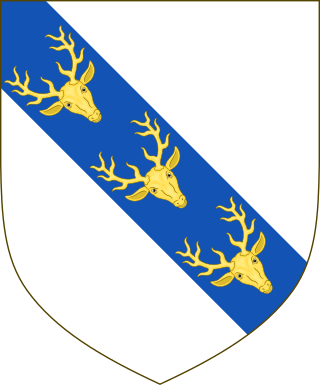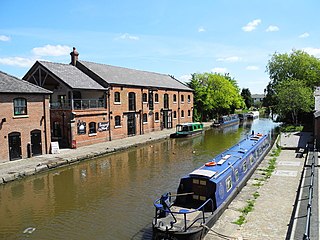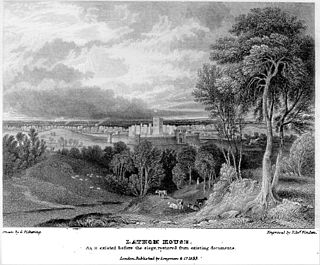
Cartmel Priory church serves as the parish church of Cartmel, Cumbria, England.

Earl of Derby is a title in the Peerage of England. The title was first adopted by Robert de Ferrers, 1st Earl of Derby, under a creation of 1139. It continued with the Ferrers family until the 6th Earl forfeited his property toward the end of the reign of Henry III and died in 1279. Most of the Ferrers property and the Derby title were then held by the family of Henry III. The title merged in the Crown upon Henry IV's accession to the throne in 1399.

Ormskirk is a market town in the West Lancashire district of Lancashire, England. It is located 13 miles (21 km) north of Liverpool, 11 miles (18 km) northwest of St Helens, 9 miles (14 km) southeast of Southport and 18 miles (29 km) southwest of Preston. Ormskirk is known for its gingerbread. In 2011 it had a population of 24,073.

Sir John Stanley, KG of Lathom, near Ormskirk in Lancashire, was Lord Lieutenant of Ireland and titular King of Mann, the first of that name. He married a wealthy heiress, Isabel Lathom, which, combined with his own great abilities, allowed him to rise above the usual status of a younger son.

Burscough is a town and civil parish in the district of West Lancashire, Lancashire, England. The town is located approximately 14 miles (23 km) north-northeast of Liverpool and 13 miles (21 km) southwest of Preston. Its northern part is called Burscough Bridge, and was originally a separate settlement.

Christchurch Priory is an ecclesiastical parish and former priory church in Christchurch in the English county of Dorset. It is one of the longest parish churches in the country and is as large as many of the Church of England Cathedrals.

Lathom is a village and civil parish in Lancashire, England, about 3 miles (5 km) northeast of Ormskirk. It is in the district of West Lancashire, and with the parish of Newburgh forms part of Newburgh ward. The population of the civil parish at the 2011 census was 914. The Leeds and Liverpool Canal passes through Lathom.

Ormskirk was a county constituency represented in the House of Commons of the Parliament of the United Kingdom. It elected one Member of Parliament (MP) by the first past the post system of election. It was created by the Redistribution of Seats Act 1885 as a division of the parliamentary county of Lancashire. The constituency boundaries were changed in 1918, 1950, 1955 and 1974.

The siege of Lathom House was a military confrontation between a Parliamentarian army and a Royalist stronghold in Lathom near Ormskirk in Lancashire, during the First English Civil War. The first siege lasted from late February to late May 1644, when the siege was lifted. The second siege took place a year later from July to December 1645. Lathom House was captured and slighted.

Lathom House was a large country house in the parish of Lathom in Lancashire, England. Built between 1725 and 1740, the main block was demolished in 1925.

Sir Thomas Stanley, 1st Baron Stanley, titular King of Mann, KG, of Lathom and Knowsley, Lancashire, was a Privy Councillor, Comptroller of the Royal Household, Lieutenant-Governor of Ireland (1431–36), Chief Steward of the Duchy of Lancaster, Knight of the Shire for Lancashire, Constable & Justice of Chester, Chamberlain of North Wales, Lord Chamberlain (1455), and from 15 January 1456 was summoned by Writ to Parliament as Lord Stanley.
Ralph Brideoake (1612/13–1678) was an English clergyman, who became Bishop of Chichester.

The Parish and Priory Church of St Mary is located in Chepstow, Monmouthshire, south east Wales. Parts of the building, including its ornate west doorway, date from the late 11th century and are contemporary with the nearby Norman castle. The church is a Grade I listed building.

Leonard Stanley Priory was a priory in Gloucestershire, England. Over the years following the dissolution most of the buildings of the priory complex have been destroyed.
Priory of St. Thomas near Stafford was an Augustinian religious house near Stafford, Staffordshire, England. Founded sometime in approximately 1174, it was a surrendered to the Crown in 1538, during the Dissolution of the Monasteries.

The Church of St Peter and St Paul is in the market town of Ormskirk, Lancashire, England. Dating from no later than the 12th century, it is one of only three churches in England to have both a tower and spire, and the only one to have them both at the same end of the church. It is an active Anglican parish church in the Diocese of Liverpool. The church is recorded in the National Heritage List for England as a designated Grade II* listed building.

The Church of St Thomas the Martyr is in School Lane, Up Holland, Lancashire, England. It is an active Anglican parish church in the deanery of Ormskirk, the archdeaconry of Warrington, and the diocese of Liverpool. The church is recorded in the National Heritage List for England as a designated Grade I listed building.

Blythe Hall is a large grade II listed country house in Lathom, Lancashire, England, some 3 miles (5 km) north-east of Ormskirk.

Westhead is a village in the West Lancashire district of Lancashire, England. As of 2014, the estimated population was 886.
The Old Town Hall was a municipal building on Church Street in Ormskirk, a town in Lancashire, in England. The building, which was the meeting place of the court leet, has since been converted for retail use.

















